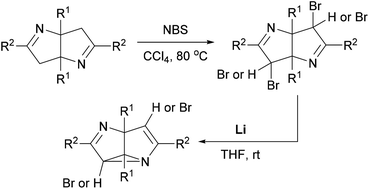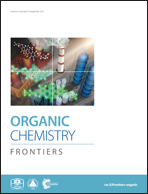Synthesis of dibromo- and tetrabromo-bipyrrolines and their corresponding 2,6-diazasemibullvalene derivatives†
Abstract
Treatment of Δ1-dipyrrolines with NBS afforded α,α′-dibromo-Δ1-bipyrrolines and α,α,α′,α′-tetrabromo-Δ1-bipyrrolines respectively with excellent selectivity depending on the amount of NBS. All these multibromo-substituted Δ1-bipyrrolines could be efficiently transformed into their corresponding 2,6-diazasemibullvalene derivatives via reduction with lithium. An unprecedented rearrangement of 4,8-dibromo-2,6-diazasemibullvalene afforded a new type of bipyrroline derivative.

- This article is part of the themed collection: Organic Chemistry Frontiers HOT articles for 2017


 Please wait while we load your content...
Please wait while we load your content...